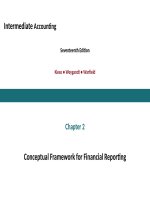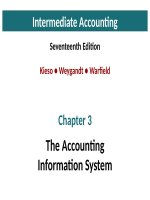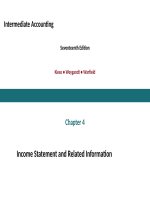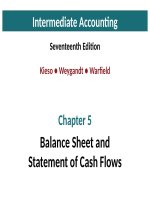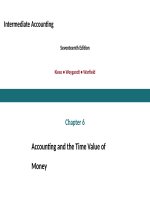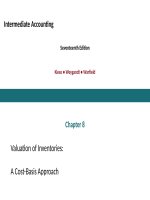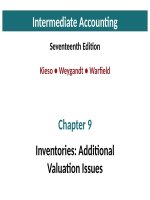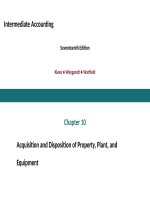Intermediate accounting 17e by kieso ch08
Bạn đang xem bản rút gọn của tài liệu. Xem và tải ngay bản đầy đủ của tài liệu tại đây (2.15 MB, 66 trang )
Intermediate Accounting
Seventeenth Edition
Kieso ● Weygandt ● Warfield
Chapter 8
Valuation of Inventories:
A Cost-Basis
Approach
This slide deck contains animations. Please disable animations if they cause issues with your device.
Learning Objectives
After studying this chapter, you should be able to:
1.
Identify inventory classifications and different inventory systems.
2.
Determine the goods and costs included in inventory.
3.
Describe and compare the cost flow assumptions used to account for inventories.
4.
Identify special issues related to LIFO.
5.
Determine the effects of inventory errors on the financial statements.
Copyright ©2019 John Wiley & Sons, Inc.
2
Preview of Chapter 8
Valuation of Inventories: A Cost-Basis Approach
Inventory Issues
•
Classification
•
Cost flow
•
Control
•
Cost of goods sold
Copyright ©2019 John Wiley & Sons, Inc.
3
Preview of Chapter 8
Goods and Costs Included in Inventory
•
Goods included
•
Costs included
Cost Flow Assumptions
•
Specific identification
•
Average-cost
•
FIFO
•
LIFO
Copyright ©2019 John Wiley & Sons, Inc.
4
Preview of Chapter 8
L I F O: Special Issues
•
L I F O reserve
•
L I F O liquidation
•
Dollar-value L I F O
•
Comparison of L I F O approaches
•
Advantages and disadvantages
•
Basis for selection
Copyright ©2019 John Wiley & Sons, Inc.
5
Preview of Chapter 8
Effect of Inventory Errors
•
Ending inventory misstated
•
Purchases and inventory misstated
Copyright ©2019 John Wiley & Sons, Inc.
6
Learning Objective 1:
Identify Inventory Classifications and Different Inventory Systems
LO 1
Copyright ©2019 John Wiley & Sons, Inc.
7
Inventory Issues
Classification
Inventories are asset:
•
items held for sale in ordinary course of business, or
•
goods to be used in production of goods to be sold
Businesses with Inventory
Merchandiser
LO 1
or
Copyright ©2019 John Wiley & Sons, Inc.
Manufacturer
8
Inventory Issues
Merchandising Company
Classification
•
One inventory account
•
Purchase merchandise in a
form ready for sale
LO 1
Copyright ©2019 John Wiley & Sons, Inc.
9
Inventory Issues
Manufacturing Company
Three accounts
LO 1
•
Raw Materials
•
Work in Process
•
Finished Goods
Copyright ©2019 John Wiley & Sons, Inc.
10
Flow of Costs
LO 1
Copyright ©2019 John Wiley & Sons, Inc.
11
Inventory Cost Flow
LO 1
Copyright ©2019 John Wiley & Sons, Inc.
12
Inventory Cost Flow
Perpetual System
1.
Purchases of merchandise are debited to Inventory.
2.
Freight-in is debited to Inventory. Purchase returns and allowances and purchase discounts
are credited to Inventory.
LO 1
3.
Cost of goods sold is debited and Inventory is credited for each sale.
4.
Subsidiary records show quantity and cost of each type of inventory on hand.
Copyright ©2019 John Wiley & Sons, Inc.
13
Inventory Cost Flow
Periodic System
1.
Purchases of merchandise are debited to Purchases.
2.
Ending Inventory determined by physical count.
3.
Calculation of Cost of Goods Sold:
Beginning inventory
$ 100,000
Purchases, net
+ 800,000
Goods available for sale
LO 1
900,000
Ending inventory
−125,000
Cost of goods sold
$775,000
Copyright ©2019 John Wiley & Sons, Inc.
14
Inventory Cost Flow
Comparing Perpetual and Periodic System
Illustration: Fesmire Company had the following transactions during the current year.
Beginning inventory
100 units at $6 = $600
Purchases
900 units at $6 = $5,400
Sales
600 units at $12 = $7,200
Ending inventory
400 units at $6 = $2,400
Record these transactions using the Perpetual and Periodic systems.
LO 1
Copyright ©2019 John Wiley & Sons, Inc.
15
Comparative Entries
Copyright ©2019 John Wiley & Sons, Inc.
16
Inventory Cost Flow
Illustration
Assume that at the end of the reporting period, the perpetual inventory account reported an inventory
balance of $4,000. However, a physical count indicates inventory of $3,800 is actually on hand. The entry to
record the necessary write-down is as follows.
Inventory Over and Short
200
Inventory
200
Note: Inventory Over and Short adjusts Cost of Goods Sold.
LO 1
Copyright ©2019 John Wiley & Sons, Inc.
17
Inventory Control
All companies need periodic verification of the inventory records
•
By actual count, weight, or measurement
•
With counts compared with detailed inventory records
Companies should take the physical inventory
LO 1
•
Near the end of their fiscal year,
•
To properly report inventory quantities in their annual accounting reports
Copyright ©2019 John Wiley & Sons, Inc.
18
Determining Cost of Goods Sold
Companies must allocate the cost of all the goods available for sale (or use) between the goods that
were sold or used and those that are still on hand.
Beginning inventory, Jan. 1
$ 100,000
Cost of goods acquired or produced during the year
800,000
Total cost of goods available for sale
900,000
Ending inventory, Dec. 31
200,000
Cost of goods sold during the year
LO 1
$700,000
Copyright ©2019 John Wiley & Sons, Inc.
19
Learning Objective 2
Determine the Goods and Costs Included in Inventory
LO 2
Copyright ©2019 John Wiley & Sons, Inc.
20
Goods and Costs Included in Inventory
Goods Included in Inventory
A company recognizes inventory and accounts payable at the time it controls the asset.
Passage of title is often used to determine control because the rights and obligations are established
legally.
LO 2
Copyright ©2019 John Wiley & Sons, Inc.
21
Goods Included in Inventory
Goods in Transit
LO 2
Copyright ©2019 John Wiley & Sons, Inc.
22
Goods Included in Inventory
Consigned Goods
LO 2
•
Goods out on consignment remain the property of the consignor
•
Consignee makes no entry to the inventory account for goods received
Copyright ©2019 John Wiley & Sons, Inc.
23
Goods Included in Inventory
Special Sales Agreements
Sales with Repurchase Agreement
•
Often referred to as a repurchase (or product financing) agreement, usually involves a
transfer (sale) with either an implicit or explicit repurchase agreement.
•
LO 2
These arrangements are often described in practice as “parking transactions.”
Copyright ©2019 John Wiley & Sons, Inc.
24
Special Sales Agreements
Sales with High Rates of Return
Seller
1.
Record sales revenue at the amount it expects to receive from the transaction.
2.
Establishes an estimated inventory return account at the date of sale to recognize that
some of its inventory will be returned.
LO 2
Copyright ©2019 John Wiley & Sons, Inc.
25
